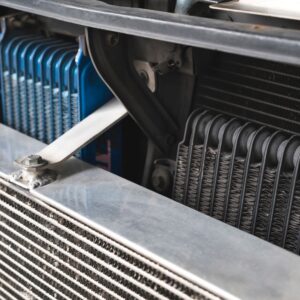Think of the engine oil cooler as a radiator for your engine oil. It can help your engine last longer by improving temperature control and reducing the risk of overheating in hot weather or when driving under heavy loads.
If you upgraded your car’s engine for more performance or you often drive in states with hot weather, an engine oil cooler might be beneficial to your vehicle. You can personally install the cooler to save on labor costs since it’s an easy DIY upgrade job.
Tips For Installing the Engine Oil Cooler Assembly
Here are some helpful tips for when you install an engine oil cooler in your car:
Prep the Work Area and Parts
Before you pop open the hood, check your work area for sharp edges and make sure not to expose the oil hoses to them. Similarly, keep track of metal surfaces that can get hot while the engine runs.
The cooler connects to the engine by way of hoses made of flexible material. These oil cooler lines can get damaged if they rub against the edges or melt in the heat released by hot surfaces.
Get Longer Oil Cooler Lines
When the oil cooler comes with hose and barbed fittings so you can tailor the length of the hose, get hoses that are somewhat longer than the required measurements. The extra length gives you leeway in case of an unexpected development. For example, if the engine oil cooler doesn’t fit in the location, you must move the heat exchanger to a different location. If the oil cooler lines prove too short and cannot reach the new location, you must get longer replacements.
You can cut off the excess length once you finish connecting the engine oil cooler and engine with the lines.

Use Fittings With Pipe Threads
A threaded pipe has one end with screw threads similar to the grooves on a screw. Pipe threads can screw into a fitting or another threaded pipe with compatible threads. Fittings with pipe threads form sturdy mechanical joints and create seals that prevent leaks.
Apply sufficient force when you tighten the engine oil cooler fittings. Insufficiently tight fittings can lead to issues like oil leaks and outright disconnection. Conversely, excessive tightening can damage the pipe thread, causing problems like the fittings getting stuck together and debris flowing through the engine oil cooler.
Where Should You Put the Engine Oil Cooler?
The engine oil cooler relies on airflow to carry away the heat radiating from its metal surface. Always install it in a place that constantly receives strong airflow.
Additionally, keep the cooler near the vehicle’s front as close to the engine’s cooling fan as possible. Even when your car doesn’t move, its cooling fan will provide enough airflow to cool the engine oil cooler.
Avoid installing the engine oil cooler behind parts that disrupt airflow or radiate heat. Examples include the A/C condenser and transmission cooler. These parts might block airflow and also generate heat that raises the temperature of the air that reaches the cooler.
Believe it or not, the driver’s wheel well is also a viable location for the engine oil cooler, as long as you can provide airflow. This is for vehicles that lack sufficient space in their engine bay to accommodate the cooler.
However, if you do install the cooler in the wheel well, you must protect it from road debris. The tire often flings small objects into its wheel well with enough force to potentially puncture the cooler. You can prevent this problem by adding a sturdy body panel to stop debris strikes.
Some engine oil coolers include electric fans that blow air over them. They rely less on external airflow than ram-air-type coolers. However, fan-equipped engine oil coolers can still take advantage of a location with naturally good airflow to improve their ability to remove heat.

Check the Oil Filter Clearance
Check the oil filter clearance before you install the engine oil cooler. There must be sufficient space between the oil filter and oil cooler adapter, which is sandwiched between the filter and the oil filter head. Otherwise, you usually have to mount the cooler in another location with enough room, although you can sometimes use a short filter instead.
Calculating the oil filter clearance is easy. Get the filter’s length and add twice the depth of the sandwich adapter for the engine oil cooler. If the sum of the two exceeds the clearance, you must look for a different location that can fit the engine oil cooler.
Plan the Layout of Oil Cooler Lines
Oil cooler lines carry heated lubricant from the engine to the oil cooler and back to the oil reservoir. You must carefully set where the lines will pass to avoid potential damage.
Keep the final length of the oil cooler lines as short as possible. Furthermore, only bend the lines when necessary.
In most set-ups, the oil filter is the recommended access point for the oil cooler lines. Its proximity to the oil pump ensures the filter receives enough pressure to propel lubricant through the lines.
If the engine oil cooler draws lubricant from the oil filter, it can cool the oil destined for the engine. The engine receives cooled oil, improving its temperature regulation during hot days and under heavy loads.
Trimming and Securing Oil Cooler Lines
Once you’ve positioned the engine oil cooler, fit the oil cooler lines and trim them to the appropriate length. Follow the manufacturer’s recommendation on how much to add and the minimum radius. Then, attach the hoses to the cooler.
If the hoses dangle uncomfortably close to sharp edges and hot surfaces, secure them with tie wraps to prevent them from moving unnecessarily.
Secure the Oil Cooler
You will need two wrenches and an electric drill to secure the engine oil cooler assembly. Use one wrench to support the cooler during the installation process. Meanwhile, use the other wrench to affix the bolts.
As for the electric drill, use it to insert the bolts into their bolt holes. The process goes faster with a power tool, saving you time and energy.
Sandwich Adapters vs. Spin-On Adapters
Engine oil coolers require an adapter for mounting and plumbing purposes. The most highly recommended adapter types are the sandwich adapter and the spin-on adapter.
The sandwich adapter mounts a spacer plate between the filter landing and the oil filter. The plate provides mounting points for oil cooler lines.
In contrast, the spin-on adapter relocates the oil filter to somewhere else. It swaps the factory-issue filter for a metal puck with two ports and O-rings.
If you use a sandwich adapter, remember that it decreases the oil filter’s ground clearance by a distance equal to the adapter’s thickness. Most adapters range between one and two inches in thickness.
Test the Engine Oil Cooler
Now that you’ve installed the engine oil cooler, you must determine if it works properly. Without turning the key on, spin the engine with the starter for 15 seconds. Wait 30 seconds and then repeat. This should fill the cooler with oil. Next, start the engine and check the oil pressure gauge. If the gauge shows normal pressure readings, the installation went off without a hitch.
Without turning the key on, spin the engine with the starter for 15 seconds. Wait 30 seconds and then repeat. This should fill the cooler with oil. Next, start the engine and check the oil pressure gauge. If the gauge shows normal pressure readings, the installation went off without a hitch.
–Richard McCuistian, ASE Certified Master Automobile Technician
If the gauge shows no pressure, shut down the engine and look for possible issues. You might have an oil leak.
Start your engine and put it in neutral, engage the parking brake, and let it idle for 10 minutes. Check it for leaks.
Another way to check if the engine oil cooler works is to touch the cooler’s ends a few minutes after starting the engine. You know the cooler works if you sense warmth and oil flow on both ends.
Last but not least, check the oil level. If you notice a dip in oil levels, add enough lubricant to top the reservoir without overfilling it.
Repeat this process several days later. Check for any leaks and issues, and resolve them.
Where to Get a High-Quality Engine Oil Cooler
Engine oil coolers come with several benefits that make them a worthwhile investment. Aside from improving temperature control, engine oil coolers allow the engine to perform better. They’re efficient and easy to install. The best part is that high-quality engine oil coolers are readily available at CarParts.com.
CarParts.com offers a wide selection of engine oil coolers that are sourced from only the most trusted manufacturers in the industry. Because we’re committed to giving you a hassle-free shopping experience, we provide accurate and detailed fitment information for each part. You can find the perfect fit for your vehicle by using our built-in vehicle selector. We’re confident in the quality of each product we sell, but if you aren’t completely satisfied with your order, you can return it within 60 days of purchase.
Don’t wait until your engine overheats before getting an engine oil cooler. Check out our selection of high-quality engine oil coolers at CarParts.com and get one today!
Any information provided on this Website is for informational purposes only and is not intended to replace consultation with a professional mechanic. The accuracy and timeliness of the information may change from the time of publication.

































